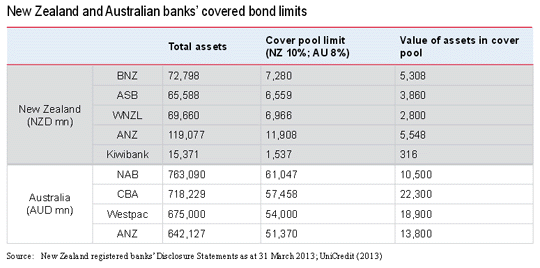
By Gareth Vaughan
New Zealand banks are allowed to use a greater chunk of their asset base as security for covered bonds than their Australian counterparts because the Reserve Bank of New Zealand says it doesn't want to prevent small banks from issuing covered bonds as this could reduce their competitiveness.
An article in the Reserve Bank's latest Bulletin entitled Discovering covered bonds – the market, the challenges, and the Reserve Bank’s response notes New Zealand banks are allowed to encumber up to 10% of their assets as collateral for covered bonds. In contrast Australian banks, including the parents of New Zealand's ANZ, ASB, BNZ and Westpac, are only allowed to use 8%.
"The Reserve Bank considers that an 8 percent limit in New Zealand could prevent the small to medium sized banks from entering the covered bonds market, or from repeat issuance," the Bulletin article says. "This could impact on competitiveness within the New Zealand banking sector."
The article notes that banks issuing covered bonds need to be able to sell them in large amounts firstly, to attract buyers on the international market, and secondly to allow the repeat issuance required for the liquidity needed to attract a wide range of investors. A typical covered bond issue in the European market can be valued between €500 million and €1 billion.
Kiwibank entered the covered bond market in March, borrowing 150 million Swiss francs (about $203 million) over seven and a half years in an issue secured by residential mortgages. However, none of New Zealand's smaller banks - such as TSB, SBS, Heartland or the Co-operative Bank - appear likely to issue covered bonds at this stage given their funding strategies are focused on retail borrowings.
New Zealand banks began issuing covered bonds in 2010, with five having done so thus far in ASB, ANZ, BNZ, Westpac and Kiwibank. As of April this year, the Reserve Bank says, combined, they've borrowed about NZ$13.954 billion through covered bonds, with issuance mostly coming in euros, Swiss francs and New Zealand dollars.
The Reserve Bank says that given banks generally build in a "safety margin" when complying with regulatory limits, the actual maximum value of a bank’s cover pool assets is likely to be be somewhat lower than 10% of its total assets, and its actual level of issuance will be lower again.
Based on this BNZ, the biggest user of covered bonds among New Zealand banks so far, has little capacity to issue any more. BNZ has encumbered about 7% of its total assets in favour of covered bonds.

Although lower, the Reserve Bank says the Australian 8% limit is specified differently from the New Zealand 10% limit, with the New Zealand limit applying at all times, and the Australian limit applying only at the time of issuance.
"In addition, if an Australian bank holds cover pool assets in excess of the limit, it must deduct the value of the excess amount from its capital in calculating its regulatory capital adequacy ratios: if a New Zealand bank breaches its cover pool limit, it is in breach of its conditions of registration. The Reserve Bank considers that a different limit for New Zealand banks is appropriate," the Bulletin article says.
Covered bonds are dual-recourse securities, usually issued for terms of several years, through which bondholders have both an unsecured claim on the issuing bank (should it default on the bonds), plus a secured interest over a specific pool of ring fenced assets - residential mortgages - called the cover pool.
Covered bonds are different to senior unsecured debt instruments issued by banks, where the bondholder is simply an unsecured creditor of the bank, and also from mortgage-backed securities, where the bondholder has a secured interest in the cover pool but has no claim on the issuing bank.
Due to their dual recourse security, covered bonds generally attract the highest possible AAA credit rating (which is higher than the bank issuer's own ratings), and are therefore a cheaper form of funding for banks than standard bank bonds. (See credit ratings explained here).
The Reserve Bank argues that limiting the percentage of assets banks can use as covered bond security to 10% balances the benefits to the banks of issuing covered bonds against the potential costs to unsecured creditors, including depositors, in the event of a bank failure. Ring fencing up to 10% of a bank's assets for covered bondholders means, in the event of a bank failure, unsecured creditors - including depositors - must be satisfied from the bank's remaining assets.
Also see: What covered bonds mean for ma & pa.
This article was first published in our email for paid subscribers. See here for more details and to subscribe.
5 Comments
The covered bond scam was always given the ok because the RBNZ didn't want the local banks to be raising deposit rates to attract cash and encourage saving...that would have diverted it from kiwisaver.and we know who benefits from the cash going into those games.
So covered bonds helped the cheaper for longer game to remain in play...and now we have a property bubble..gee you don't spose there might be a link there do you!
what a farce.
Year 8 rugrats will see the connections...unaffordable housing...property bubble...taxfree gains...cheap credit...shoddy return on savings...sick govt...How many other links would they spot I wonder.
And Mun and Dad savers left empty handed if the banks default and other Mum and Dad home owners left with under water morgages after their house values reduce. Truely sick government.
Now, I don't want to be accused of scare mongering so let me say here and now that New Zealand's major banks are currently all in vigorously healthy financial shape and long may they remain so.
Is that so? - can we prove this point or is it just accepted hearsay.
Healthy as a horse SH...until the bubble pops...then it's off to the knackers yard.
The reserve bank stress tests are impressive with lots of incomprehensible formulas. Their senarios seem to revolve around falls in house prices in the 20-25% area accompanied by increases in unemployment. The outcome may be reassuring to some.
I come from Northern Ireland and in the last few years they have seen 50% declines in property values and modest unemployment rises. The property value declines do not seem to have been triggered by the same issues plaguing the Republic of Ireland.
Perhaps it would be more prudent for our Reserve Bank to anticipate greater potential falls in property value in a worst case banking scenario. Why don't they buy some gold?
At least I do have the option of lending my money to banks in countries where the Government or the banking system, offer specific guarantees to depositors!

We welcome your comments below. If you are not already registered, please register to comment.
Remember we welcome robust, respectful and insightful debate. We don't welcome abusive or defamatory comments and will de-register those repeatedly making such comments. Our current comment policy is here.